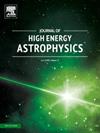Dark Universe inspired by the Kaluza-Klein gravity and impact on primordial gravitational waves
IF 10.5
4区 物理与天体物理
Q1 ASTRONOMY & ASTROPHYSICS
引用次数: 0
Abstract
We explore the potential implications of Kaluza-Klein (KK) gravity in unifying the dark sector of the Universe. Through dimensional reduction in KK gravity, the 5D spacetime framework can be reformulated in terms of a 4D spacetime metric, along with additional scalar and vector fields. From the 4D perspective, this suggests the existence of a tower of particle states, including KK gravitons with massive spin-0 and spin-1 states, in addition to the massless spin-2 gravitons of general relativity (GR). The key idea in the present paper is the analogy with superconductivity theory. By assuming a minimal coupling between an additional complex scalar field and the gauge field, a “mass” term emerges for the spin-1 gravitons. This, in turn, leads to long-range gravitational effects that could modify Newton's law of gravity through Yukawa-type corrections. Assuming an environment-dependent mass for the spin-1 graviton, near the galactic center the repulsive force from this spin-1 graviton is suppressed by an additional attractive component from Newton's constant corrections, resulting in a Newtonian-like, attraction-dominated effect. In the galaxy's outer regions, the repulsive force fades due to its short range, making dark matter appear only as an effective outcome of the dominant attractive corrections. This approach also explains dark matter's emergence as an apparent effect on cosmological scales while our model is equivalent to the scalar-vector-tensor gravity theory. Finally, we examine the impact of dark matter on the primordial gravitational wave (PGW) spectrum and show that it is sensitive to dark matter effects, providing an opportunity to test this theory through future GW observatories.
黑暗宇宙的灵感来自卡鲁扎-克莱因引力和对原始引力波的影响
我们探讨了卡卢扎-克莱因(KK)引力在统一宇宙暗部方面的潜在影响。通过 KK 引力的降维,5D 时空框架可以用 4D 时空度量以及额外的标量场和矢量场来重新表述。从 4D 的角度来看,这表明存在一个粒子状态塔,除了广义相对论(GR)中的无质自旋-2 引力子之外,还包括具有大质量自旋-0 和自旋-1 状态的 KK 引力子。本文的关键观点是与超导理论的类比。通过假设额外的复杂标量场与规量场之间的最小耦合,自旋-1 引力子出现了一个 "质量 "项。这反过来又会导致长程引力效应,从而通过尤卡瓦型修正修正牛顿万有引力定律。假设自旋-1引力子的质量与环境有关,那么在星系中心附近,自旋-1引力子产生的斥力会被牛顿常数修正产生的额外吸引力分量所抑制,从而产生类似牛顿的、以吸引力为主的效应。在星系的外围区域,斥力因其范围较短而逐渐减弱,使得暗物质仅作为占主导地位的吸引力修正的有效结果出现。当我们的模型等同于标量-矢量-张量引力理论时,这种方法也解释了暗物质在宇宙学尺度上作为一种明显效应出现的原因。最后,我们研究了暗物质对原始引力波(PGW)频谱的影响,并表明它对暗物质效应很敏感,这为通过未来的引力波天文台检验这一理论提供了机会。
本文章由计算机程序翻译,如有差异,请以英文原文为准。
求助全文
约1分钟内获得全文
求助全文
来源期刊

Journal of High Energy Astrophysics
Earth and Planetary Sciences-Space and Planetary Science
CiteScore
9.70
自引率
5.30%
发文量
38
审稿时长
65 days
期刊介绍:
The journal welcomes manuscripts on theoretical models, simulations, and observations of highly energetic astrophysical objects both in our Galaxy and beyond. Among those, black holes at all scales, neutron stars, pulsars and their nebula, binaries, novae and supernovae, their remnants, active galaxies, and clusters are just a few examples. The journal will consider research across the whole electromagnetic spectrum, as well as research using various messengers, such as gravitational waves or neutrinos. Effects of high-energy phenomena on cosmology and star-formation, results from dedicated surveys expanding the knowledge of extreme environments, and astrophysical implications of dark matter are also welcomed topics.
 求助内容:
求助内容: 应助结果提醒方式:
应助结果提醒方式:


